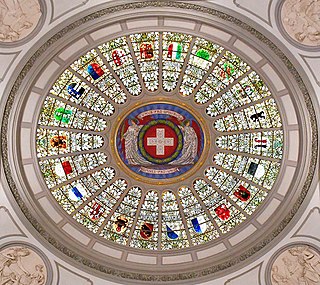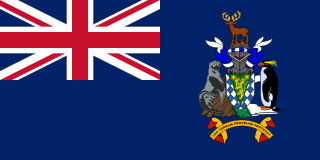
The coat of arms of Canada, also known as the Royal Coat of Arms of Canada or, formally, as the Arms of His Majesty The King in Right of Canada, is the arms of dominion of the Canadian monarch and, thus, also the official coat of arms of Canada. In use since 1921, it is closely modelled after the royal coat of arms of the United Kingdom, with French and distinctive Canadian elements replacing or added to those derived from the British version.

The coat of arms of the United Kingdom are the arms of dominion of the British monarch. They are both the personal arms of the monarch, currently King Charles III, and the arms of the state. In addition to the monarch, the arms are used by state institutions including the Government of the United Kingdom, the Parliament of the United Kingdom, and the British judiciary. Differenced versions of the arms are used by members of the British royal family. The monarch's official flag, the Royal Standard, is the coat of arms in flag form.

The coat of arms of Australia, officially the Commonwealth Coat of Arms, is a formal symbol of the Commonwealth of Australia. It depicts a shield, containing symbols of Australia's six states, and is held up by native Australian animals, the kangaroo and the emu. The seven-pointed Commonwealth Star surmounting the crest also represents the states and territories, while golden wattle, the national floral emblem, appears below the shield.

The coat of arms of Germany displays a black eagle with a red beak, a red tongue and red feet on a golden field, which is blazoned: Or, an eagle displayed sable beaked langued and membered gules. This is the Bundesadler, formerly known as Reichsadler. It is one of the oldest coats of arms in the world, and today the oldest national symbol used in Europe.

Each of the 26 modern cantons of Switzerland has an official flag and a coat of arms. The history of development of these designs spans the 13th to the 20th centuries.

The coat of arms of France is an unofficial emblem of the French Republic. It depicts a lictor's fasces upon branches of laurel and oak, as well as a ribbon bearing the national motto of Liberté, égalité, fraternité. The full achievement includes the star and grand collar of the Legion of Honour. This composition was created in 1905 by heraldic painter-engraver Maurice de Meyère, and it has been used at the Foreign Ministry during state visits and for presidential inaugurations.

The coat of arms of Finland is a crowned lion on a red field, the right foreleg replaced with an armoured human arm brandishing a sword, trampling on a sabre with the hindpaws. The coat of arms was originally created around the year 1580.

Polish heraldry is the study of the coats of arms that have historically been used in Poland and the Polish–Lithuanian Commonwealth. It treats of specifically Polish heraldic traits and of the Polish heraldic system, contrasted with heraldic systems used elsewhere, notably in Western Europe. Due to the distinctive ways in which feudal societies evolved, Poland's heraldic traditions differ substantially from those of the modern-day German lands and France.

The coat of arms of Russia derives from the earlier coat of arms of the Russian Empire. Though modified more than once since the reign of Ivan III (1462–1505), the current coat of arms is directly derived from its medieval original, with the double-headed eagle having Byzantine and earlier antecedents. The general tincture corresponds to the fifteenth-century standard.

The coat of arms of the Kingdom of the Netherlands was originally adopted in 1815 and later modified in 1907. The arms are a composite of the arms of the former Dutch Republic and the arms of the House of Nassau, it features a checkered shield with a lion grasping a sword in one hand and a bundle of arrows in the other and is the heraldic symbol of the monarch and the country. The monarch uses a version of the arms with a mantle while the government of the Netherlands uses a smaller version without the mantle (cloak) or the pavilion, sometimes only the shield and crown are used. The components of the coats of arms were regulated by Queen Wilhelmina in a royal decree of 10 July 1907, affirmed by Queen Juliana in a royal decree of 23 April 1980.

A cross pattée, cross patty, or cross paty, also known as a cross formy or cross formée, is a type of Christian cross with arms that are narrow at the centre, and often flared in a curve or straight line shape, to be broader at the perimeter. The form appears very early in medieval art, for example in a metalwork treasure binding given to Monza Cathedral by Lombard queen Theodelinda, and the 8th-century lower cover of the Lindau Gospels in the Morgan Library. An early English example from the start of the age of heraldry proper is found in the arms of Baron Berkeley.

The coat of arms of Georgia is one of the national symbols of Georgia. The coat of arms is partially based on the medieval arms of the Georgian royal house and features Saint George, the traditional patron saint of Georgia. In addition to St. George, the original proposal included additional heraldic elements found on the royal seal, such as the seamless robe of Jesus, but this was deemed excessively religious and was not incorporated into the final version.

The flag of Winnipeg was adopted in October 1975 to represent the City of Winnipeg. Today, the flag with its crest is used as the official representation of the city for ceremonial and official purposes, while the logo flag is used for promotional purposes.

The coat of arms of Scotland, colloquially called the Lion Rampant, is the coat of arms historically used as arms of dominion by the monarchs of the Kingdom of Scotland, and later by monarchs of Great Britain and the United Kingdom. The coat of arms, or elements from it, are also used in heraldry to symbolise Scotland in general. The arms consist of a red lion surrounded by a red double border decorated with fleurs-de-lis, all on a gold background. The blazon, or heraldic description, is: Or a lion rampant Gules armed and langued Azure within a double tressure flory-counter-flory of the second.

The flag of South Georgia and the South Sandwich Islands was granted on 3 October 1985, when the Territory was created. Previously the Territory was a part of the former Falkland Islands Dependencies and used the same flag as the Falklands Islands.

The coat of arms of Denmark has a lesser and a greater version.

The coat of arms of Portugal is the main heraldic insignia of Portugal. The present model was officially adopted on 30 June 1911, along with the present model of the Flag of Portugal. It is based on the coat of arms used by the Kingdom of Portugal since the Middle Ages. The coat of arms of Portugal is popularly referred as the Quinas.

The rose is a common device in heraldry. It is often used both as a charge on a coat of arms and by itself as an heraldic badge. The heraldic rose has a stylized form consisting of five symmetrical lobes, five barbs, and a circular seed. The rose is one of the most common plant symbols in heraldry, together with the lily, which also has a stylistic representation in the fleur-de-lis.

The coat of arms of Greenland is a blue shield charged with an upright polar bear. This symbol was first introduced in the coat of arms of Denmark in 1666 and it is still represented in the arms of the Danish royal family. In a Danish context, the bear was originally shown walking naturally, but an upright position was specified in 1819. The 1470 London Roll shows an arms captioned Le Roy de Greneland featuring a shield depicting a polar bear surrounded by three birds. This royal title did not reflect any official title, but merely that the arms could be used by anyone controlling Greenland.
A national coat of arms is a symbol which denotes an independent state in the form of a heraldic achievement. While a national flag is usually used by the population at large and is flown outside and on ships, a national coat of arms is normally considered a symbol of the government or the head of state personally and tends to be used in print, on armorial ware, and as a wall decoration in official buildings. The royal arms of a monarchy, which may be identical to the national arms, are sometimes described as arms of dominion or arms of sovereignty.



















